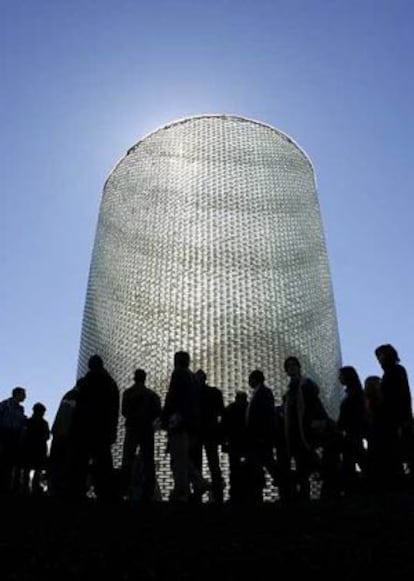Spain’s forgotten terrorism memorials
Many of the country’s monuments to ETA and Al Qaeda victims are lying neglected

Ángeles Pedraza lost her daughter in the March 11, 2004 train bombings in Madrid. In 2012, she visited the monument in Atocha railway station to leave some flowers to the 193 people killed in the jihadist terrorists attacks. “They almost called security,” she recalls. “We hadn’t asked permission. It was horrible. I left the flowers and went. They were later taken away.” Pedraza, who is president of the Association of Terrorism Victims (AVT), says she isn’t at all surprised that the monument is in poor repair, adding that the authorities turned their backs on the families of those killed in the bombings the moment it was unveiled in 2007.
For the last two months, visitors to the monument will have encountered a large plastic sheet covered with messages to the deceased lying on the floor underneath the glass-brick cylinder inside of which it is supposed to be inflated.
Sadly, the Atocha memorial is far from the only monument to terrorism victims abandoned by the authorities: Spain is littered with projects in similar disrepair, such as the sculpture dedicated to Fernando Múgica – the Basque Socialist Party politician murdered by ETA in 1996 – in woodland outside San Sebastián, which has been vandalized and left to the elements.
Do such memorials serve any real purpose? And how do the families and loved ones of those whose memory they commemorate feel? Do they even bother visiting them? Everybody EL PAÍS spoke to in Spain praised the shrine at the Twin Towers in New York, and categorized the Atocha monument as its antithesis.
Everybody praised the shrine at the Twin Towers in New York, and categorized the Atocha monument as its antithesis
“No love went into its creation,” says Pilar Manjón, the president of the 11-M victims association. “No street signs telling people where to find it have even been put up. Nobody knows which government department is responsible for it. It was made without consulting the families of the victims; it was done too quickly, without any thought. In the end, it isn’t anybody’s. There isn’t even anything there saying what it is,” she says, adding that she finally overcame her fear of returning to Atocha three months ago. “I had to go, and so I went. Alone, at three in the afternoon. It was very sad.”
Behind Atocha station lies Téllez street, where one of the bombed train carriages exploded. In the weeks and months that followed the attacks, people came here to leave flowers. “But it wasn’t looked after and soon became a mess: thank goodness they finally put up a fence,” says Manjón. She, like Pedraza and other relatives of the victims, prefer the monument erected at the nearby El Pozo station.
“I love it. It’s a public square, a place for everybody. It should be a place of memory, where you can sit down, spend a little time, or cry if you want to. I prefer symbols, sculptures of people are painful,” says Manjón.
The Atocha memorial was done too quickly, without any thought. In the end, it isn’t anybody’s” Pilar Manjón, head of the 11-M victims association
There are more than 100 memorials of different kinds to the victims of the attacks throughout Spain, many of them unofficial, and many of the families say they feel closer to them. Pedraza says the important thing is “not to simply commission some well-known architect or somebody’s friend, but to find an artist who is sensitive.”
People have a personal relationship to these places. Nobody really knows what kind of design will bring a memorial closer to people, but one essential ingredient is affection, warmth.
“To Fernando and Jorge – his bodyguard – we planted a palm tree here in Vitoria,” says Jesús Loza, who heads the Fernando Buesa Foundation, which was set up in honor of the Basque politician murdered by ETA in 2000. “It seemed the perfect thing to do. It’s growing and is looked after.” He believes the question of how to honor and remember the victims of terrorism affects society as a whole, not just the families and friends of those who died. “It’s an obvious thing to say, but forgetting places of memory goes against remembering.” It sounds like a play on words, but Loza insists that memorials need to be cared for, and if we forget to care for them, we forget to remember.
In Vitoria itself, a memorial to all the people killed by ETA has fallen into disrepair. Consuelo Ordóñez, the sister of politician Gregorio Ordóñez, who was murdered in 1995, is president of COVITE, which represents ETA victims killed in the Basque Country and that campaigned to have the monument built. She says she’s tired of asking city authorities to repair the site. “They pay no attention. They never have. The problem is that nobody really cares, nobody ever stops in front of the monument to think about what happened. Renaming a street makes more sense.”
The debate on commemorating the victims of terrorism is in a very different place in the Basque Country where there are any number of place where bombings, kidnappings, and shootings took place and where local people have no idea of what happened. Monuments may one day be erected, so that they too can be forgotten. Vitoria is very much the exception: of the region’s three provincial capitals, it is the only one that has plaques commemorating where attacks took place. “Not long ago, we placed 80 plaques throughout San Sebastián in a single night, but they’ve almost all been taken down, and there are just four left,” says Ordóñez. He placed a plaque in honor of his brother. It was removed the next day. All that was left was a spot of glue. It’s a powerful symbol of how memory should resist.
Tu suscripción se está usando en otro dispositivo
¿Quieres añadir otro usuario a tu suscripción?
Si continúas leyendo en este dispositivo, no se podrá leer en el otro.
FlechaTu suscripción se está usando en otro dispositivo y solo puedes acceder a EL PAÍS desde un dispositivo a la vez.
Si quieres compartir tu cuenta, cambia tu suscripción a la modalidad Premium, así podrás añadir otro usuario. Cada uno accederá con su propia cuenta de email, lo que os permitirá personalizar vuestra experiencia en EL PAÍS.
¿Tienes una suscripción de empresa? Accede aquí para contratar más cuentas.
En el caso de no saber quién está usando tu cuenta, te recomendamos cambiar tu contraseña aquí.
Si decides continuar compartiendo tu cuenta, este mensaje se mostrará en tu dispositivo y en el de la otra persona que está usando tu cuenta de forma indefinida, afectando a tu experiencia de lectura. Puedes consultar aquí los términos y condiciones de la suscripción digital.
Últimas noticias
From digital curfews to blocking apps: How technology experts protect their children online
Why the price of coffee has skyrocketed: from Brazilian plantations to specialty coffee houses
Confined to a Cuban hospital: When electricity is a matter of life or death
The complicated life of Francesca Albanese: A rising figure in Italy but barred from every bank by Trump’s sanctions
Most viewed
- Why we lost the habit of sleeping in two segments and how that changed our sense of time
- Pablo Escobar’s hippos: A serious environmental problem, 40 years on
- Trump’s obsession with putting his name on everything is unprecedented in the United States
- The Florida Keys tourist paradise is besieged by immigration agents: ‘We’ve never seen anything like this’
- Charles Dubouloz, mountaineering star, retires at 36 with a farewell tour inspired by Walter Bonatti









































